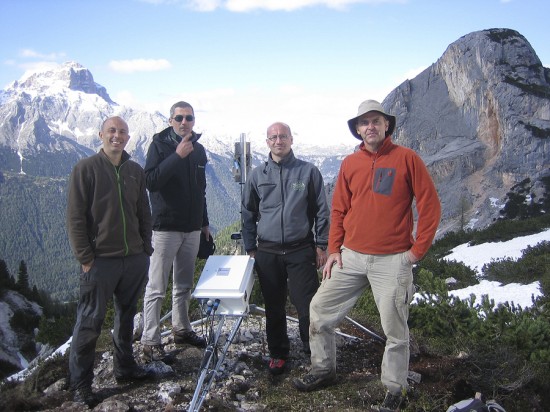Forecasting Disasters
The professor who chairs the Department of Geology and Geography is hoping his research in Italy’s Dolomite Alps, will one day lead to the development of an early warning system for debris flows, or a type of landslide.
“Debris flows are really mean and nasty. The wall of debris can be as large as boulders. They can come down as fast as 40 miles per hour and will knock houses off foundations or split houses into pieces. They are really dangerous natural hazards.”
So warns Jeffrey Underwood, Ph.D., as he explains that because debris flows strike so suddenly, in most instances, warnings are issued only after one has been visually identified, which can be too late for anyone to take evasive action.
Underwood has been studying debris flows since 2005, primarily concentrating on an alpine area in northeastern Italy. “It has the highest frequency of debris flow on the planet,” he said. “In some places, you can set up your equipment and you might wait one, two, or three years and never see a debris flow, but almost every year in this region called the Dolomites you will see multiple debris flows. Dolomite is a material that is easily broken apart, so there is a lot of loose material there and this material on extremely steep slopes is easily mobilized by water.”
This summer Underwood and his two Italian research collaborators are installing new instruments including an electric field meter on a mountainside near the town of Cortina d’Ampezzo in northeastern Italy, near the Austrian border. The Italian researchers are geologists, who focus on measuring the amount of debris flow that crashes down steep slopes, while Underwood, a meteorologist examines the atmospheric conditions that lead to debris flows.
“I study thunderstorms (which as the name implies include lightning and thunder), and I study the lightning a bit differently than most,” he said. “I try to use the lightning as a predictor for other things that happen during storms. The electric field meter will help us determine which storms are likely to produce debris flows and which are harmless. … We will collect data detailing the electrical properties of many different storms and then identify the electrical signature of storms prone to producing intense localized rainfall in the debris flow zone. The electric field meter allows us to look at this process in many different clouds and cloud clusters and determine why one cloud system actually produces the heavy rainfall and another does not. If we can actually get a handle on which cloud types are more likely to produce intense local rainfall then we can build better warnings for debris flows.”
Other equipment already built into the research site includes geologic sensors to detect the movement of earth and meteorological instruments that measure rainfall, wind direction, speed and temperature. According to the professor, the site is meant to be a permanent research site and more funding will allow him to add undergraduates to the project. “I have hopes of turning the study site into a study abroad research destination for students, who would get University credit for doing field research,” Underwood said. “They could go for a month or so in the summer, collect and analyze meteorological and geological data and publish their findings as part of a study abroad experience,” he added. “Between thunderstorms they can tour the cultural landscape of Italy and learn to speak Italian.”
As he sees it, the debris flow research raises Georgia Southern’s international profile. “We want global scholars and working in Italy helps the profile. The two geologists I am working with are probably the two most recognized debris flow researchers in the world so affiliating myself with these gentlemen elevates my research profile and at the same time reflects very positively on the University.“
Before arriving in Statesboro, Underwood was a professor at the University of Nevada and the Nevada State Climatologist. In the latter role, he headed the state agency that oversaw the collection of climate data for the state of Nevada, conducted climate and drought analysis for the state, made drought declarations for the U.S. Department of Agriculture and provided assistance to other agencies such as FEMA. –Sandra Bennett

